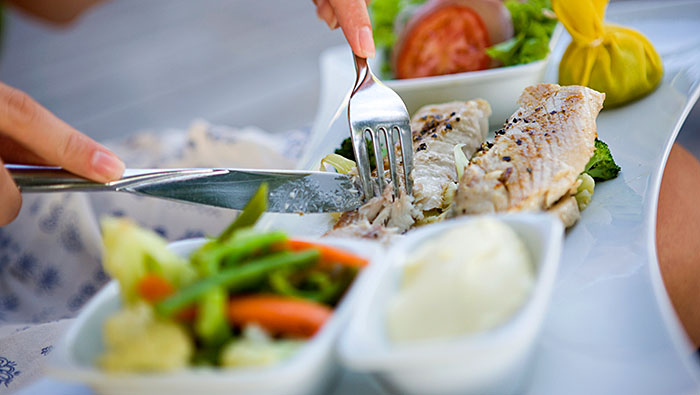- Fruits and vegetables, whole grains, and
- Fat-free or low-fat milk products;
- Lean meats, poultry, fish, beans, eggs, and nuts; and is low in saturated fats, trans fats, cholesterol, salt (sodium), and added sugars.
An Average Weekly Menu should include the following ingredients:
- 2 Chicken/Turk Dishes
- 2 Fish Dishes
- 1 Pork Dish
- 1 Beef Dish
- 1 Meatless Dish
The Heart Healthy Food Groups:
- Salmon
This ocean-going fish is a top choice because it’s rich in omega-3 fatty acids. “Omega-3s have an anti-clotting effect, so they keep your blood flowing,” says Rachel Johnson, PhD, RD, Bickford Professor of Nutrition at the University of Vermont. They also help lower your triglycerides (a type of fat that can lead to heart disease).
Aim for at least two servings of oily fish each week, says the American Heart Association. A serving is 3.5 ounces. That’s a little bit bigger than a computer mouse.
Other options: Tuna, trout, sardines, and mackerel.
- Walnuts.
Nibbling on 5 ounces of nuts each week may cut your risk of heart disease in half. Walnuts have lots of “good” fats. When you use these monounsaturated fats in place of saturated fats (such as butter), you cut your “bad” LDL cholesterol and raise your “good” HDL cholesterol.
Walnuts are also a good source of omega-3 fats. (They don’t have the same kind of omega-3s as fish, though.)
Other options: Almonds, cashews, pistachios, flaxseed, and chia seeds.
- Raspberries
These berries are loaded with polyphenols — antioxidants that mop up damage-causing free radicals in your body. They also deliver fiber and vitamin C, which are both linked to a lower risk of stroke.
Other options: Any berries — strawberries, blueberries, blackberries — are great choices. Fruits and vegetables in general are excellent choices because of their nutrients and fiber.
- Fat-Free or Low-fat Milk or Yogurt
“Dairy products are high in potassium, and that has a blood-pressure-lowering effect,” Johnson says. When you choose low-fat or fat-free dairy, you get little to no saturated fat, the kind of fat that can raise your cholesterol.
Other options: Most fruits and vegetables also have some potassium, Johnson says. Bananas, oranges, and potatoes are especially good sources.
- Chickpeas
Chickpeas and other legumes (lentils, other kinds of beans) are a top-notch source of soluble fiber — the kind of fiber that can lower your “bad” LDL cholesterol. If you buy canned beans, look for low-sodium or no-salt-added varieties (sodium can raise your blood pressure). Rinse them in water to wash off any added salt.
- Oatmeal
Oats have a type of fiber (called beta-glucan) that lowers your LDL cholesterol. One and a half cups of cooked oatmeal or a little over a cup of cooked barley gives you the amount of beta-glucan you need daily to help lower your cholesterol.
Other options: You can also find beta-glucan in barley, shiitake mushrooms, and seaweed.
- Olive oil
A cornerstone of the traditional Mediterranean diet, olive oil is a great pick when you need to limit saturated fat (found in meat, whole milk, and butter). Fats from animal products, and trans fats (“partially hydrogenated oils”) raise your “bad” cholesterol and can make fat build up inside your arteries.
Other options: Canola oil and safflower oil.
- Dark Chocolate
Cacao, the plant from which chocolate is made, is rich in flavanols, which can help lower your blood pressure and prevent blood clots. It also acts as an antioxidant, which can keep “bad” cholesterol from sticking to your artery walls.
Choose dark chocolate (at least 70% cocoa) to get more flavanols and less sugar, Johnson says. (Sugar raises your risk of heart disease.)
Other options: Think beyond the bar. Choose natural cocoa powder over Dutch-processed to get more flavanols. (Check the label to make sure you don’t get too much sugar.) For a totally unsweetened take, try cacao nibs. Add them to your granola.
- Avocados
These fruitsget their creamy texture from “good” (monounsaturated) fats, which lower your “bad” cholesterol.
“They also seem to have an anti-inflammatory effect, so you don’t get chronic inflammation that makes atherosclerosis — the hardening of artery walls — worse,” Johnson says.
Use mashed avocado as a spread in place of butter, or add cubes of it to salad, or over black bean chili. As delicious as they are, avocados are high in calories, so keep your portions modest.
Other options: Nuts and sunflower oil.
10. Unsalted almond butter
Nut butters are great on whole-grain toast instead of butter. They’re a wonderful source of monounsaturated fatty acids. Use unsalted, natural options to avoid added salt, sugar, and hydrogenated fats found in other forms of peanut butter, Johnson says.
- Red Grapes
These juicy fruits have resveratrol, which helps keep platelets in your blood from sticking together.
That may partly be why red wine — in moderation (1 glass for women, 2 for men) — may have some heart-healthy advantages over other types of alcohol. But health experts don’t recommend that anyone start drinking, because alcohol does have some health risks.
Love your nightly glass of wine? You can ask your doctor to make sure your serving size is OK for you. And feel free to go for grapes straight from the vine anytime.
Other options: Black grapes.

